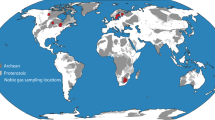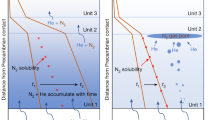Abstract
Aquitards—layers of rock having low permeability—have been suggested as potential long-term reservoirs for toxic materials such as nuclear or chemical waste. But information about the isolation properties of aquitard layers is essential to evaluate whether they can indeed be used safely as reservoirs. Here we investigate the long-term mobility of groundwaters between two aquifers surrounding an aquitard layer in the eastern recharge area of the Paris basin, France, using helium isotopes as a geochemical tracer. The deeper Trias sandstone aquifer, which lies above the crystalline basement, accumulates radiogenic 4He and primordial 3He from large regions of the crust and mantle at rates comparable to the degassing of the whole crust1 and of mid-ocean ridges2. We show that the overlying carbonate Dogger aquifer, which is separated from the Trias aquifer by an aquitard layer consisting of a ∼600 m succession of shales and clays, is stagnant and has been extremely well isolated from the Trias over the past several million years. This finding, together with previous studies at the centre of the Paris basin3,4, shows that diffusive mass transfer across aquitards is negligible and that cross-formational flow in basins takes place preferentially in faulted areas.
This is a preview of subscription content, access via your institution
Access options
Subscribe to this journal
Receive 51 print issues and online access
$199.00 per year
only $3.90 per issue
Buy this article
- Purchase on Springer Link
- Instant access to full article PDF
Prices may be subject to local taxes which are calculated during checkout


Similar content being viewed by others
References
Torgersen, T. & Clarke, W. B. Helium accumulation in groundwater. I: an evaluation of sources and the continental flux of crustal 4He in the Great Artesian Basin, Australia. Geochim. Cosmochim. Acta 49, 1211–1218 (1985)
Craig, H., Clarke, W. B. & Beg, M. A. Excess 3He in deep waters on the East Pacific Rise. Earth Planet. Sci. Lett. 26, 125–132 (1975)
Matray, J. M., Lambert, M. & Fontes, J. C. Stable isotope conservation and origin of saline waters from the Dogger aquifer of the Paris basin, France. Appl. Geochem. 9, 297–309 (1994)
Pinti, D. L. & Marty, B. Noble gases in crude oils from the Paris basin, France—Implications for the origin of fluids and constraints on oil-water interactions. Geochim. Cosmochim. Acta 59, 3389–3404 (1995)
Tolstikhin, I. N., Lehmann, B. E., Loosli, H. H. & Gautschi, A. Helium and argon isotopes in rocks, minerals, and related groundwaters: A case study in northern Switzerland. Geochim. Cosmochim. Acta 60, 1497–1514 (1996)
Ballentine, C. J., Burgess, R. & Marty, B. Tracing fluid origin, transport and interaction in the crust. Rev. Mineral. 47, 539–614 (2002)
Ohsumi, T. & Horibe, Y. Diffusivity of He and Ar in deep-sea sediments. Earth Planet. Sci. Lett. 70, 61–68 (1984)
Rebour, V., Billiotte, J., Deveughele, M., Jambon, A. & le Guen, C. Molecular diffusion in water-saturated rocks: a new experimental method. J. Contam. Hydrol. 28, 71–93 (1997)
Mégnien, C. Synthèse géologique du Bassin de Paris. Mém. BRGM 101, 1–466 (1980)
Menjoz, A., Lambert, M. & Matray, J. M. Flow of formation waters in the Jurassic of the Paris basin, France. Phil. Trans. R. Soc. Lond. A 344, 141–156 (1994)
Pinti, D. L. & Marty, B. in Dating and Duration of Fluid Flow and Fluid-Rock Interaction (ed. Parnell, J.) 53–68 (Geol. Soc. Spec. Publ., London, 1998)
Marty, B., Torgersen, T., Meynier, V., O'Nions, R. K. & de Marsily, G. Helium isotope fluxes and groundwater ages in the Dogger Aquifer, Paris basin. Wat. Resour. Res. 29, 1025–1035 (1993)
Castro, M. C., Jambon, A., de Marsily, G. & Schlosser, P. Noble gases as natural tracers of water circulation in the Paris basin. 1. Measurements and discussion of their origin and mechanisms of vertical transport in the basin. Wat. Resour. Res. 34, 2443–2466 (1998)
Blavoux, B. & Olive, P. Radiocarbon dating of groundwater of the aquifer confined in the lower Triassic sandstones of the Lorraine region, France. J. Hydrol. 54, 167–183 (1981)
Marine, I. W. The use of naturally occurring He to estimate groundwater velocities for studies of geological storage waste. Wat. Resour. Res. 15, 1130–1136 (1979)
Ozima, M. & Podosek, F. A. Noble Gas Geochemistry (Cambridge Univ. Press, Cambridge, 2002)
Andrews, J. N. et al. A radiochemical, hydrochemical and dissolved gas study of groundwaters in the Molasse basin of Upper Austria. Earth Planet. Sci. Lett. 73, 317–332 (1985)
Ungemach, T. Les ressources géothermiques de la Communauté Européenne. Etat de l'exploration, perspectives de développement. Hydrologie-Géologie de l'Ingénieur 1, 11–42 (1984)
Rousset, D., Bayer, R., Guillon, D. & Edel, J.-B. Structure of the southern Rhine Graben from gravity and reflection seismic data (ECORS-DEKORP program). Tectonophysics 221, 135–153 (1993)
Torgersen, T. Terrestrial helium degassing fluxes and the atmospheric helium budget: Implications with respect to the degassing processes of continental crust. Chem. Geol. 79, 1–14 (1989)
Griesshaber, E., O'Nions, R. K. & Oxburgh, E. R. Helium and carbon isotope systematics in crustal fluids from the Eifel, the Rhine graben and Black Forest, F.R.G. Chem. Geol. 99, 213–235 (1992)
Kellogg, L. H. & Wasserburg, G. J. The role of plumes in mantle helium fluxes. Earth Planet. Sci. Lett. 99, 276–289 (1990)
Wörner, G. & Schmincke, H. U. Petrogenesis of the zoned Laacher See Tephra. J. Petrol. 25, 836–851 (1984)
Worden, R. H. & Matray, J. M. Cross formational flow in the Paris basin. Basin Res. 7, 53–66 (1995)
Bard, E., Hamelin, B., Fairbanks, R. G. & Zindler, A. Calibration of the 14C timescale over the past 30,000 years using mass spectrometric U-Th ages from Barbados corals. Nature 345, 405–409 (1990)
Ingerson, E. & Pearson, F. J. in Recent Researches in the Fields of Hydrology, Atmosphere and Nuclear Geochemistry (eds Miyake, Y. & Koyama, T.) 263–283 (Maruzen, Tokyo, 1964)
Fontes, J. C. & Garnier, J. M. Determination of the initial 14C activity of total dissolved carbon: A review of existing models and a new approach. Wat. Resour. Res. 15, 399–413 (1979)
Richard, D., Marty, B., Chaussidon, M. & Arndt, N. Helium isotopic evidence for a lower mantle component in depleted Archean Komatiite. Science 273, 93–95 (1996)
Report B RP 0ANT 01–010/B, 1–158 (ANDRA, Fontenay-Aux-Roses, 2002).
Kloppman, W., Matray, J. M. & Aranyossy, J. F. Contamination of deep formation waters by drillings fluids: correction of the chemical and isotopic composition and evaluation of errors. Appl. Geochem. 16, 1083–1096 (2001)
Acknowledgements
This study was supported by the French Nuclear Waste Agency (ANDRA) and by the Région Lorraine. We are grateful to all institutions and individuals who made sampling possible. Analytical support was provided by G. Sauder, P. Robert and L. Zimmermann. We appreciated comments from D. Hilton.
Author information
Authors and Affiliations
Corresponding author
Ethics declarations
Competing interests
The authors declare that they have no competing financial interests.
Rights and permissions
About this article
Cite this article
Marty, B., Dewonck, S. & France-Lanord, C. Geochemical evidence for efficient aquifer isolation over geological timeframes. Nature 425, 55–58 (2003). https://doi.org/10.1038/nature01966
Received:
Accepted:
Issue Date:
DOI: https://doi.org/10.1038/nature01966
This article is cited by
-
Hydrochemistry and gas geochemistry of the northeastern Algerian geothermal waters
Arabian Journal of Geosciences (2017)
-
Detecting inter-aquifer leakage in areas with limited data using hydraulics and multiple environmental tracers, including 4He, 36Cl/Cl, 14C and 87Sr/86Sr
Hydrogeology Journal (2017)
-
Dissolved noble gases and stable isotopes as tracers of preferential fluid flow along faults in the Lower Rhine Embayment, Germany
Hydrogeology Journal (2016)
-
Review: Deep groundwater research with focus on Germany
Hydrogeology Journal (2012)
Comments
By submitting a comment you agree to abide by our Terms and Community Guidelines. If you find something abusive or that does not comply with our terms or guidelines please flag it as inappropriate.



